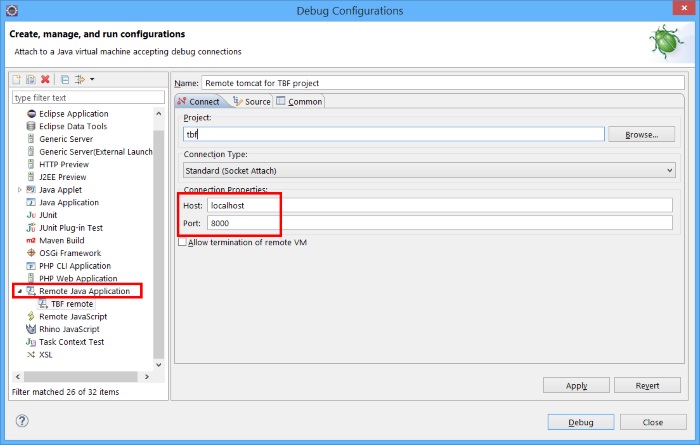Remote debugging
Server side
Starting your server in remote debug mode (JPDA with default socket connection mode) has a very significant negative impact on its performances. Make sure to do is only in development and to disable it when you don't use it.
Docker
When using our standard images you can (re)start your container with JPDA enabled by adding
-e JPDA=true -p <port, e.g. 8000 or 12345>:8000 to your docker run command.
See this document for details.
Simplicité Instances Manager (SIM)
When using a SIM server, to restart an instance in debug mode you have to stop Tomcat sim tomcat-stop and restart it in JPDA mode sim tomcat-debug.
The exposed JPDA port is specific to each instance (it is only opened when the instance is running in debug mode)
and is available in the JPDA_ADDRESS environment variable.
Tomcat
When using a "traditional" deployments of Tomcat 9.x servers you can (re)start Tomcat in JPDA mode by doing the following change
in the startup script startup.sh (the change is to add the keyword jpda before start):
(...)
exec "$PRGDIR"/"$EXECUTABLE" jpda start "$@"
By default the listening port is 8000 but you can change it to any port by setting the JPDA_ADDRESS environment variable
to another value:
JPDA_ADDRESS=12345
export JPDA_ADDRESS
Alternatively you can add following option to JVM arguments:
-agentlib:jdwp=transport=dt_socket,server=y,address=8000,suspend=n
Debugger side
The server's debug port must be accessible from the local machine running the debugger. For remote instances, this can be achieved by either opening the port in the server's firewall or, preferably, by setting up an SSH tunnel to securely forward the port.
For instance:
ssh -L 8000:localhost:12345 <user>@<server>
will make the remote 12345 port available locally on local port 8000.
Such tunnels can also easily be configured using SSH GUIs clients like PuTTY.
Then you can configure a remote debug configuration in your IDE pointing to localhost:8000
(or directly on <server>:12345 if you have chosen to open the remote port thru the server firewall).
Then , provided that you have a copy of your modules' code locally in the IDE you will be able to define breakpoints, do step by step debugging, etc.
VSCode
Configure your launch.json like this:
{
"version": "0.2.0",
"configurations": [
{
"type": "java",
"name": "My instance",
"request": "attach",
"hostName": "<server>", (e.g. localhost or your server's hostname or IP address)
"port": <port> (e.g. 8000 or 12345)
},
(...)
]
}
Eclipse
Configure and launch a "Remote Java Application":
